Hyundai Santa Cruz: Engine Control / Fuel System / Troubleshooting
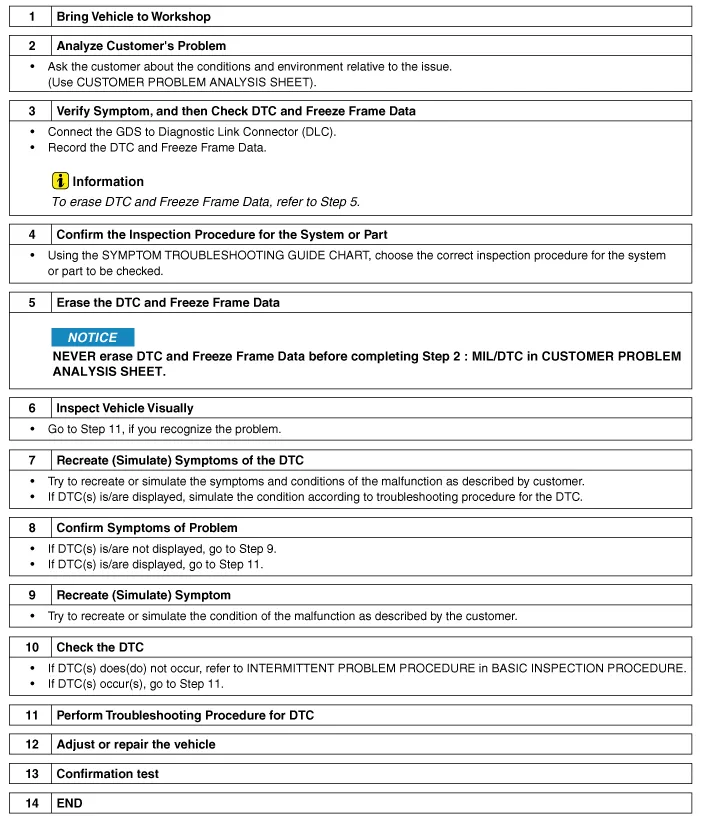
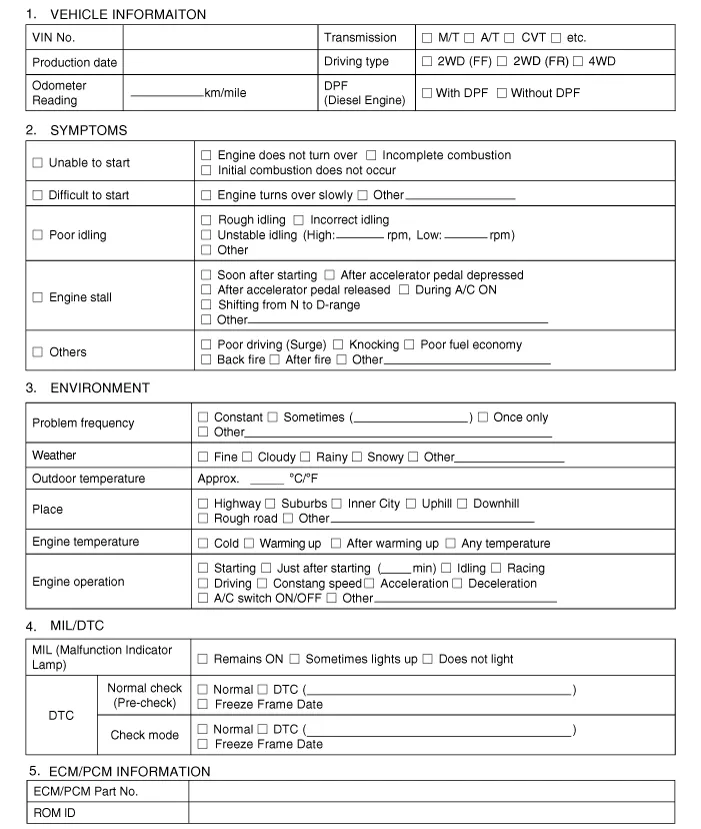

• The measured resistance except at ambient temperature (20°C, 68°F) is the reference value.
Intermittent Problem Inspection ProcedureSometimes the most difficult case in troubleshooting is when a problem symptom occurs but does not reoccur during test. An example would be if a problem appears only when the vehicle is cold but has not appeared when warm. In this case, the technician should thoroughly make out a "Customer Problem Analysis Sheet" and recreate (simulate) the environment and condition in which the vehicle was having the issue.1.Clear Diagnostic Trouble Code (DTC).
2.Inspect all connections, check terminal for poor connections, loose wires, bent, broken or corroded pins, and then verify that the connectors are securely fastened at all times.
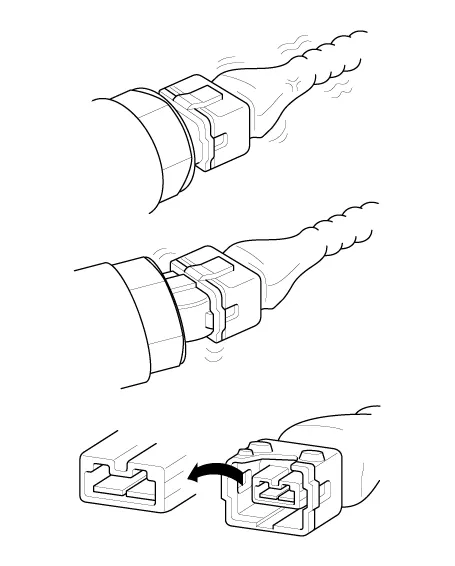
3.Lightly shake the connector and wiring harness vertically and horizontally.
4.Repair or replace the component with a problem.
5.Perform road test to verify that the problem has disappeared.
● Simulating Vibrationa.Sensors and Actuators: Lightly shake sensors, actuators or relays by finger.

• Strong vibration may break sensors, actuators or relays.
b.Connectors and Harness: Lightly shake the connector and wiring harness vertically and then horizontally.
● Simulating Heata.Heat components suspected of causing the malfunction with a hair dryer or other heat source.

• DO NOT heat components to the point of damaging them.
• DO NOT heat the ECM directly.
● Simulating Water Sprinklinga.Sprinkle water onto vehicle to simulate a rainy day or a high humidity condition.

• DO NOT sprinkle water directly onto the engine compartment or electronic components.
● Simulating Electrical Loada.Turn on all electrical systems to simulate an excessive electrical load. (Radios, fans, lights, rear window defogger, etc.)
1.Handling of Connector
a.Never pull on the wiring harness when disconnecting connectors.
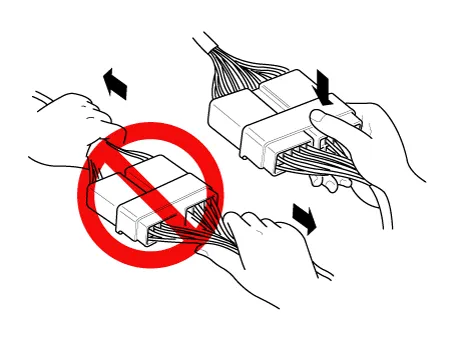
b.When removing the connector with a latch, press or pull locking lever.
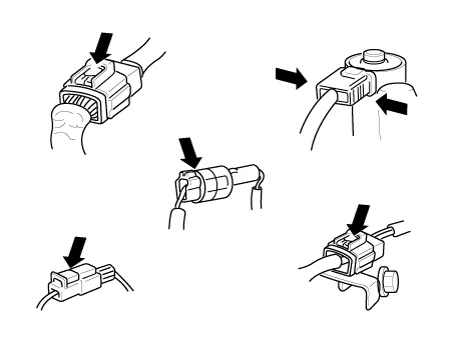
c.Listen for a click when locking connectors. This sound indicates that they are securely locked.
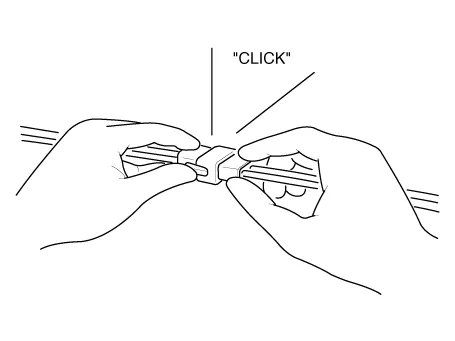
d.When a tester is used to check for continuity, or to measure voltage, always insert tester probe from wire harness side.
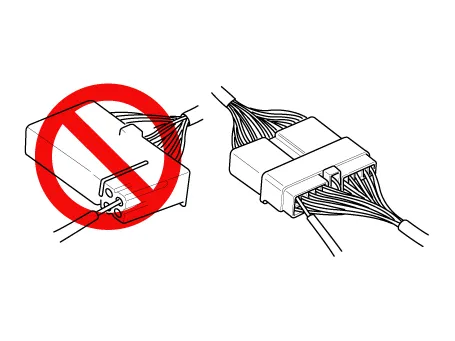
e.Check waterproof connector terminals from the connector side. Waterproof connectors cannot be accessed from harness side.
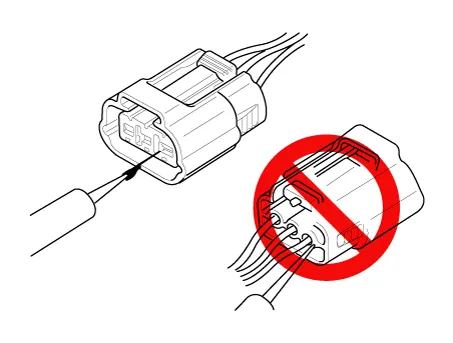

• Use a fine wire to prevent damaging the terminal.
• Do not damage the terminal when inserting the tester lead.
2.Checking Point for Connector
a.While the connector is connected :Hold the connector, and check connecting condition and locking efficiency.
b.When the connector is disconnected :Check for missing terminal, crimped terminal or broken core wire by lightly pulling the wire harness.Visually check for rust, contamination, deformation and bending.
c.Check terminal tightening condition :Insert a spare male terminal into a female terminal, and then check terminal tightening conditions.
d.Pull lightly on individual wires to ensure that each wire is secured in the terminal.
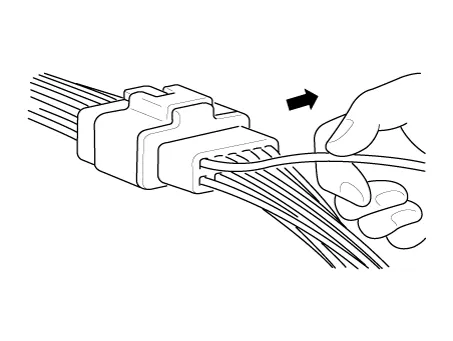
3.Connector Terminal Repairing Method
a.Clean the contact points using air gun and/or shop rag.

• Never use sand paper when polishing the contact points, otherwise the contact point may be damaged.
b.In case of abnormal contact pressure, replace the female terminal.
1.Before removing the wire harness, check the wire harness position and crimping in order to restore it correctly.
2.Check for twisted, pulled or loose wire harness.
3.Check if the temperature of the wire harness is abnormally high.
4.Check for rotating, moving or vibrating wire harness against the sharp edge of a part.
5.Check the connection between the wire harness and any installed part.
6.If the covering of wire harness is damaged; secure, repair or replace the harness.
1.Procedures for Open Circuit
• Continuity Check
• Voltage Check
If an open circuit occurs (as seen in [FIG. 1]), it can be found by performing Step 2 (Continuity Check Method) or Step 3 (Voltage Check Method) as shown below.
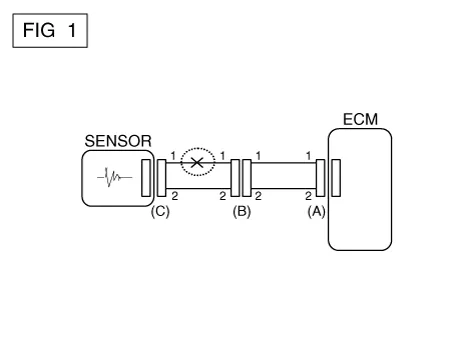
2.Continuity Check Method

• When measuring the resistance, lightly shake the wire harness vertically or horizontally.
Specification (Resistance)1Ω or less → Normal Circuit1MΩ or Higher → Open Circuit
a.Disconnect connectors (A) and (C), and measure resistance between connectors (A) and (C) as shown in [FIG. 2].In [FIG. 2], if the measured resistances in lines 1 and 2 are "over 1 MΩ" and "below 1Ω" respectively, line 1 has an open circuit. (Line 2 is normal.) To find the exact broken point, check the sub line of line 1 as described in the next step.
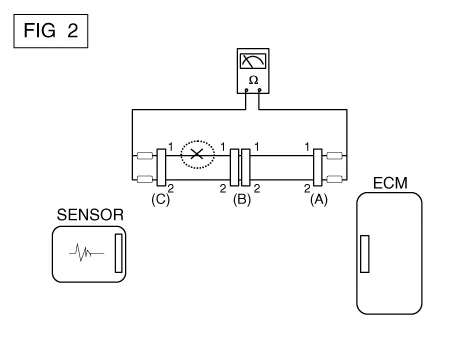
b.Disconnect connector (B), and measure the resistances between connectors (C) and (B1), and between (B2) and (A) as shown in [FIG. 3].In this case, the measured resistance between connectors (C) and (B1) is higher than 1 MΩ and the open circuit is between terminal 1 of connector (C) and terminal 1 of connector (B1).
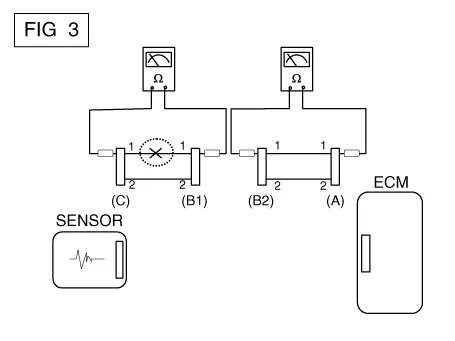
3.Voltage Check Method
a.With each connector still connected, measure the voltage between the chassis ground and terminal 1 of each of connectors (A), (B) and (C) as shown in [FIG. 4].The measured voltages of connectors are 5V, 5V and 0V respectively. So the open circuit is between connectors (C) and (B).
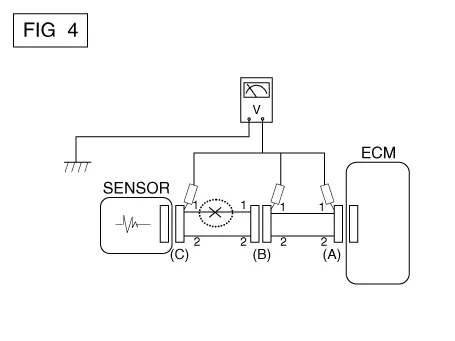
1.Test Method for Short to Ground Circuit
• Continuity Check with Chassis Ground
If short to ground circuit occurs as shown in [FIG. 5], the broken point can be found by performing Step 2 (Continuity Check Method with Chassis Ground) as shown below.
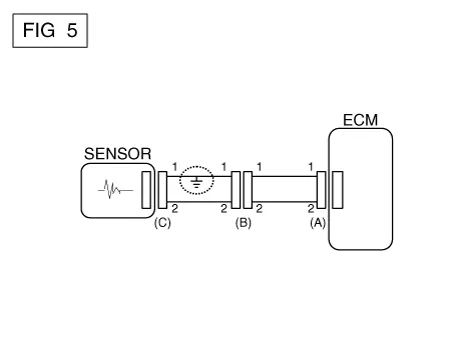
2.Continuity Check Method (with Chassis Ground)

• Lightly shake the wire harness vertically or horizontally when measuring the resistance.
Specification (Resistance)1Ω or less → Short to Ground Circuit1MΩ or Higher → Normal Circuit
a.Disconnect connectors (A) and (C), and measure the resistance between connector (A) and Chassis Ground as shown in [FIG. 6].If the measured resistances in lines 1 and 2 are "below 1 Ω" and "over 1 MΩ" respectively, line 1 has an open circuit. (Line 2 is normal.) To find the exact broken point, check the sub line of line 1 as described in the next step.

b.Disconnect connector (B), and measure the resistances between connector (A) and chassis ground, and between (B1) and chassis ground as shown in [FIG. 7].The measured resistance between connector (B1) and chassis ground is 1Ω or less. The short to ground circuit is between terminal 1 of connector (C) and terminal 1 of connector (B1).
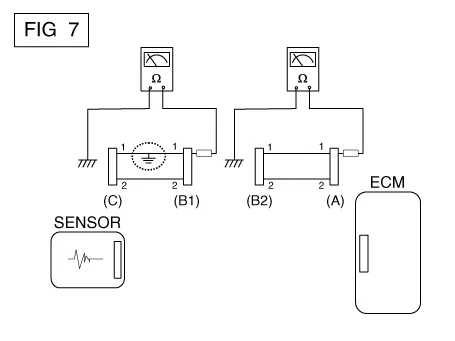
A.Connect the positive lead of a voltmeter to the end of the wire (or to the side of the connector or switch) closest to the battery.
B.Connect the negative lead to the other end of the wire (or the other side of the connector or switch).
C.Operate the circuit.
D.The voltmeter will show the difference in voltage between the two points. A difference, or drop of more than 0.1 volts (50mV in 5V circuits), may indicate a problem. Check the circuit for loose or dirty connections.
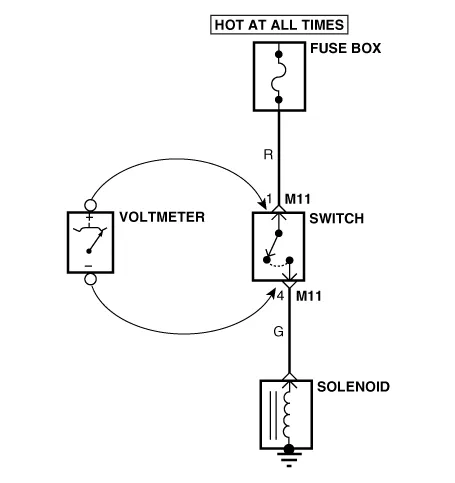
| Main symptom | Diagnostic procedure | Also check for | ||||||||||||||||||||||
| Unable to start (Engine does not turn over) |
| |||||||||||||||||||||||
| Unable to start (Incomplete combustion) |
|
| ||||||||||||||||||||||
| Difficult to start |
|
| ||||||||||||||||||||||
| Poor idling (Rough, unstable or incorrect idle) |
|
| ||||||||||||||||||||||
| Engine stalling |
|
| ||||||||||||||||||||||
| Poor driving (Surge) |
|
| ||||||||||||||||||||||
| Knocking |
|
| ||||||||||||||||||||||
| Poor fuel economy |
|
| ||||||||||||||||||||||
| Hard to refuel (Overflow during refueling) |
|
|
 Special Service Tools
Special Service Tools
- Special Service Tools
Tool (Number and name)IllustrationApplication
09353-24100Fuel Pressure Gauge
Measuring the fuel line pressure
0K353-D4100Fuel Pressure Gauge Adapter
Connection between the ...
Other information:
Hyundai Santa Cruz 2021-2025 Owners Manual: Locking your vehicle (Touch sensor
type)
1. Make sure that all doors are closed.
2. While having the Smart Key in your
possession, touch the outer part of
the door handle on or near the handle
detent for about 1 second or until you
hear the door locks actuate.
3. The doors will be locked. If the tailgate
was open, then when the tailg ...
Hyundai Santa Cruz (NX4A OB) 2021-2025 Service Manual: Front Door Latch
- Components Location
1. Front door latch
- Replacement
1.Remove the front door module.(Refer to Front Door - "Front Door Module")
2.Remove the front door inside handle cage (A).
3.Separate the front door outside handle base connector and wiring harness (A).
4.Separate the front ...

